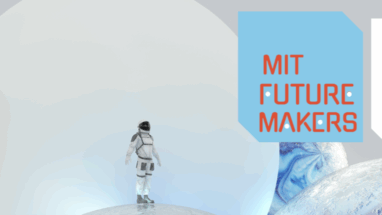Six weeks of learning, building, and collaborating came to an energetic close on August 8 at the MIT FutureMakers 2025 Create-a-Thon finale, a virtual celebration of student creativity and community impact. The program, run by the MIT Responsible AI for Social Empowerment and Education (RAISE) Initiative, trains high school and early college students to design with AI and digital technologies for social good. Many participants came from under-resourced communities, and all left with new skills, expanded networks, and the confidence to lead.
A summer of commitment
Event host Taniya Mishra, PhD, leader of longtime MIT FutureMakers collaborator SureStart, set the tone with program milestones: a 55%+ female cohort, with all participants investing over 90 hours of work – about the same as a semester-long class. Students spent 4 hours daily for 5.5 weeks, built 21 mobile apps, held 378 group mentor meetings, sent roughly 5,000 Discord messages, and completed fourteen capstone projects. They also benefited from 20+ hours of advice from twelve education and innovation experts.
“You decided to invest in yourself,” Mishra told them, noting how they had turned that investment into tangible, impactful work.
Spotlight on Kentucky
FutureMakers highlighted a partnership with the Floyd County School of Innovation in Martin, Kentucky, made possible by a Google.org grant. Students worked on-site at the University of Pikeville on a project using sensors and MIT App Inventor to automate decisions about plant and mushroom growth in mine environments. Their AI system achieved 90% accuracy on water and light decisions, compared to 74% for humans. Mushrooms, they noted, could be cultivated for both food and medicine.
This segment underscored how FutureMakers connects AI learning to local economic and environmental opportunities.
Student teams tackle big challenges
This year’s presentations came from two of the program’s three tracks – Mobile App Development & AI and Deep Learning. The third track, Data in Action, held its own Symposium earlier, demonstrating how students learned to analyze data critically, to apply Python for fundamental data science skills, and to partner with community organizations to support their missions. Those projects culminated in presentations to partners, friends, and family for feedback.
From the two presenting tracks, teams pitched projects that blended technical ambition with human-centered design using the ethical matrix principles of respect for wellbeing, autonomy and fairness:
- Team Visioneers – “ChalkIT” A communication tool for middle and high school students, especially neurodiverse learners, to share concerns with teachers “without fear of judgment.” After surveying 78 students and 16 teachers/parents, the team found a gap in trusted tools for those uncomfortable speaking up. ChalkIT includes market analysis, ethics mapping, and values of well-being, autonomy, and fairness.
- Team GARRY – “Phonix” Addressing the 70% of 8th graders rated non-proficient in reading, this app combines flashcard games, Madlibs-style exercises, customizable learning patterns, and interactive games. A freemium model supports accessibility. Primary research included surveys via Discord and Reddit. Future features could include diagnostics, translation, and personalized learning paths.
- Team BubbleBytes – “PetNet” Tackling the narrow window for rescuing stray animals before euthanasia, PetNet connects community members with shelters and provides adopter education.
- Team Code and Chaos – “Hand2Hand” Aimed at food insecurity and waste reduction, Hand2Hand connects donors and volunteers to transport surplus food. Surveys found high school volunteers willing to give 9 hours/week and interested in badges/service hours. Future expansions could include hygiene products, clothing, and school supplies.
- Team Data Minions – “Kaikoon” A task manager for neurodiverse teens, Kaikoon uses ChatGPT to break goals into microsteps and adapts based on user mood check-ins. AI recommendations evolve through feedback.
- Team NeuroSync For pediatric eating disorder recovery, where 45% relapse after leaving the hospital, NeuroSync focuses on collaboration between patients and caregivers, summarizing recovery data for doctors. Its AI was trained on peer-reviewed journal articles.
Judges asked probing questions on market size, accessibility, feature expansion, and ethics – encouraging teams to think about long-term viability and inclusivity.
Mentors as “star makers”
After the pitches, Mishra praised mentors as “our star makers – the ones who turn the potential that our students have into reality”. She credited them with creating “so much psychological safety” through accountability, support, and empathy. A mentor tribute video showcased their advice and encouragement.
Skills, friendships, and computational action
Cynthia Breazeal, Dean of Digital Learning at MIT and Founding Director of MIT RAISE, congratulated students for both technical and human achievements. She encouraged them to embrace “computational action” – using technology to create positive change — and shared examples of alumni applying their FutureMakers experiences to college essays, prize competitions, and internships.
Awards and recognitions
Breazeal introduced the Overall Program Rock Stars, one per track: Jasleen Pabla for Deep Learning, Giada Jiménez for Mobile App Development & AI, and Violette Rosario for Data in Action.
The Good Citizen Awards for the most students went to Hasini Parepalli, Michaela Beakley, and “Juan Pablo Jiménez-Blanco.”
And then the big winners – the teams for the two Create-a-Thon tracks – were:
- Mobile App Development & AI: Team Code and Chaos – Anushka Gontla, Harshini Karukola, Sanjana Madishetti, Catalina Cabrera, and Gaythri Vongolu.
- Deep Learning: Team NeuroSync – Kacira Foster, Mikaela Beakley, Jay Keshav Ahuja, Sean Manuel Cogburn-Enchautegui, Shreya Chougule, and Jasleen Pabla.
A launchpad for change
Mishra closed by reflecting on FutureMakers’ origins in late 2020 and the mission to “overcome the barriers of geography and barriers of cost” in AI education. She left students with a charge: “Do good, be amazing, and this is just the beginning.”
For many participants, the Create-a-Thon was more than a competition. It showed that their ideas – whether improving food distribution, supporting mental health, or boosting literacy – can create tangible impact. Students left with technical skills, strong mentors, and stories to carry into whatever challenge they take on next.
